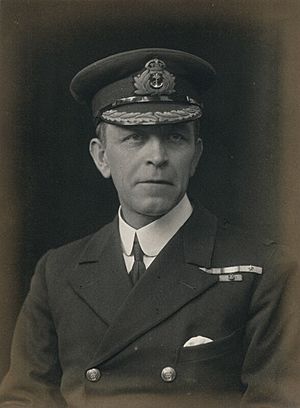Percy Douglas facts for kids
Quick facts for kids
Sir Percy Douglas
|
|
|---|---|
 |
|
| Birth name | Henry Percy Douglas |
| Born | 1 November 1876 Higher Bebington, Cheshire, England |
| Died | 4 November 1939 (aged 63) Dover, Kent, England |
| Allegiance | |
| Service/ |
|
| Years of service |
|
| Rank | Vice Admiral |
| Commands held |
|
| Battles/wars | |
| Awards |
|
Sir Henry Percy Douglas (born November 1, 1876 – died November 4, 1939) was a British naval officer. He was known for his skills in surveying and for leading the Hydrographic Department of the Navy. This department creates maps and charts of the oceans. He held the rank of Vice-Admiral.
Contents
Henry Percy Douglas started his naval training in 1890 at Eastman's Royal Naval Academy. He then joined the training ship HMS Britannia. In 1892, he became a midshipman on HMS Cleopatra.
In 1894, he was part of a group that landed in Bluefields, Nicaragua. This was during a campaign to add the Mosquito Coast to Nicaragua. He later joined Majestic in 1895. By 1896, he was promoted to sub-lieutenant. He then served on HMS Stork, which was a surveying ship. He worked on many surveying ships around the world. In 1898, he became a lieutenant.
Leading Surveying Missions
In 1908, Douglas took command of his first ship, the surveying vessel Waterwitch. From 1910 to 1914, he worked as the Superintendent of Charts. This role was in the Hydrographic Department of the British Admiralty. He was promoted to Commander on December 31, 1910.
Service During World War I
When World War I began, Douglas played an important role. In February 1915, during the Dardanelles Campaign, he was sent to help Admiral John de Robeck. Douglas's surveying skills were very helpful for the fleet. His work was key for successful landing operations.
He was promoted to acting captain in October 1915. After the Gallipoli peninsula was evacuated in January 1916, Douglas returned to the Admiralty. He became the Director of the Naval Meteorological Service. In 1918, Admiral Roger Keyes asked Douglas to join his team in Dover. Douglas helped plan the Zeebrugge Raid and the First Ostend Raid. These were important naval attacks. For his service, he received the Companion of the Order of St Michael and St George (CMG). He also received awards from Belgium and Italy.
After the war, Douglas continued his important work. From 1919 to 1921, he was the Assistant Hydrographer of the Navy. He then commanded HMS Mutine from 1921 to 1923. He also briefly commanded HMS Ormonde in 1924. During this time, he conducted surveys in British Guiana and the West Indies.
In October 1924, he became the Hydrographer of the Navy. Around this time, he created the Douglas Sea Scale. This scale helps describe how rough the sea is. As Hydrographer, he supported using echo sounding to measure ocean depth. This new method was faster and more accurate. It helped find hidden dangers in the ocean. He was promoted to Rear-Admiral in 1927. He retired from the Navy in 1932.
Later Life and Return to Service
After retiring, Douglas held several important positions. He was involved with the River Mersey and the House of Lords. From 1934 to 1939, he was the chairman of the Dover Harbour Board. He also chaired a committee for an expedition to Antarctica.
When World War II started in September 1939, he returned to the Navy. He was appointed commodore superintendent of Dover. Sadly, he passed away in Dover on November 4, 1939.
Awards and Recognition
Percy Douglas received several honors for his service. He was made a Companion of the Order of St Michael and St George (CMG) in 1918. He also became a Companion of the Order of the Bath (CB) in 1929. In 1933, he was knighted and became a Knight Commander of the Order of the Bath (KCB). This meant he could use "Sir" before his name.
Some places in Antarctica are named after him. These include the Douglas Range, Douglas Islands, and Douglas Strait.
Family Life
Henry Percy Douglas was born in Higher Bebington, Cheshire. His father was Admiral Sholto Douglas. In 1899, he married Katherine Chute Mackenzie. They had one daughter.

